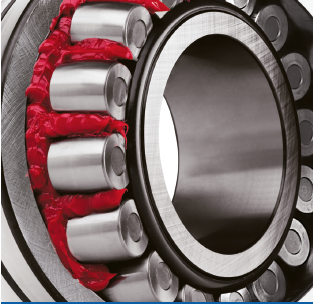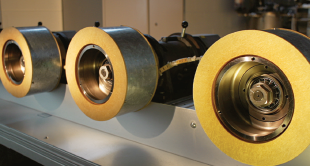Don't get burned by high-temperature grease claims
Technical Topic
Grease upper-operating-temperature claims
Don’t get burned by high-temperature grease claims
Â
High-temperature claims can be confusing
Grease upper-operating-temperature claims can be based upon many different tests and standards, leading to significant variability across products and suppliers. This can lead to confusion when trying to select the best product for a specific application. Unless the basis of the upper-operating-temperature claim is clearly understood, users risk experiencing undesired consequences by potentially selecting a grease with insufficient high-temperature performance.
Â
 Dropping point — the old way of doing things
Historically, upper-operating-temperature claims were based upon the dropping point of a grease. The dropping-point test, however, was intended primarily as a manufacturing quality-control test to confirm proper thickener formation, rather than as a performance indicator. The dropping point indicates the temperature at which, under static high-temperature conditions, the grease thickener loses the capacity to retain oil. This approach has no direct relationship to real-life, dynamic high-temperature performance—nor does the common practice of subtracting an arbitrary number of degrees from the grease dropping point to represent the grease’s maximum operating temperature.
Â
 Bearing tests — a modern approach
Standardized bearing tests offer a more accurate assessment of the upper-operating temperature of a grease. Such tests simulate the dynamic conditions of a grease in use, and are conducted under accelerated operating conditions to promote the grease aging processes. Factors limiting a grease’s ability to perform and provide lubrication at high temperatures include degradation resulting from thickener and base oil oxidation, and the loss of base oil due to grease bleed and evaporation. In general, these dynamic grease life determinations better represent actual grease usage conditions, providing a more realistic measure of agrease’s upper-operating-temperature limit than claims based on dropping point. Bearing tests also can help determine required grease relubrication intervals at normal operating temperatures.
Â

Â
Several standard industry tests can be employed to evaluate a grease’s upper operating temperature limit. In
these tests, several bearing assemblies are run in parallel under predefined conditions, until failure occurs. The hours to grease failure in each assembly are treated using Weibull statistics to determine the time at which 50 percent of the bearings are expected to fail. This measurement defines the ‘‘L50’’ life of the grease at the chosen test temperature.
Industrial high-temperature grease tests
• ASTM Method D3336, commonly known as the ‘‘Spindle Life’’ or ‘‘Pope’’ test, employs five 6204 ball bearings at 10,000 rpm under a duty cycle 20 hours on / 4 hours off. Grease failure is determined by temperature excursion or excessive bearing torque.
• The SKF R0F+ test employs two 6204 test ball bearings in continuous operating mode in five test rigs. Grease failure is determined by bearing temperature excursion. The R0F+ test has flexibility to vary both speed and load, typical test conditions are a light load and 10,000 rpm. The continuous upper-operating-temperature limit for a grease is determined by the highest temperature at which the L50 life will exceed 1,000 hours.
• The DIN 51821 (or FAG FE9) test (Figure A) uses 7206B angular contact ball bearings, run in one of three standard modes. The most common mode is Method A, employing unshielded 7206B bearings packed with 2ml of grease, run at 6,000 rpm and a 1,500 N axial load. Grease failure is determined by bearing torque increase, as indicated by an increase in the power requirement of the rig motor. Under the DIN 51825:2004-06 Classification system for Greases Type K (NLGI Classes 1-4), the maximum temperature at which a grease may be used for continuous lubrication is defined as the highest temperature at which an L50 of 100 hours is achieved.
Â

Â
Assessing grease performance
Understanding how the temperature capability of a grease has been defined allows a user to make a more informed lubrication decision. For example, the upperoperating- temperature limit of Mobilgrease XHP™ 222 based upon a dropping point criterion might conservatively be given as 180°C (356°F). Mobilith SHC™ 220 and Mobil SHC Polyrex™ 462 greases, both with a similar dropping point, would typically be accorded a higher upperoperating- temperature limit by virtue of the improved high-temperature performance of the synthetic base oil. By contrast, the upper-operating temperature for continuous operation determined through DIN 51821 (FAG FE9) bearing tests would be given as 140°C (284°F) for Mobilgrease XHP 222,150°C (302°F) for Mobilith SHC 220, and 170°C (338°F) for Mobil SHC Polyrex 462 (Figure B). The difference in temperature limits determined from dropping point and bearing test criteria are highly significant, translating into a considerable extension in expected grease life.

Â
ExxonMobil bases upper-operating-temperature limit recommendations for continuous operation on the results of bearing tests, at the same time recognizing that operation at temperatures exceeding this recommendation may be tolerated for short periods with appropriate adjustments to relubrication intervals. When assessing the potential of different greases to satisfy the needs of an application, it is important to ensure the basis used to compare upper operating temperature claims is the same.
Don’t forget the fundamentals
The base oil component of the grease is primarily responsible for lubrication, and the correct base oil viscosity ensures that an oil film of adequate elastohydrodynamic (EHL) thickness is formed. Users should remember that viscosity may well be the limiting factor for a given grease at the equipment operating temperature.
Choosing a grease with the right upper-operating temperature limit, defined by bearing test results, and the right base oil, is the key to successful lubrication in challenging high-temperature environments.












